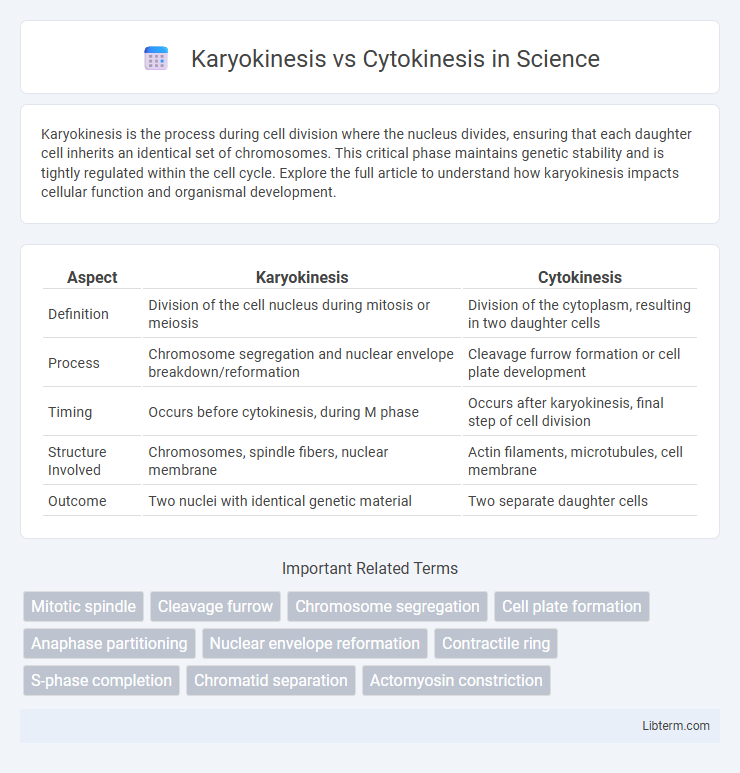Karyokinesis is the process during cell division where the nucleus divides, ensuring that each daughter cell inherits an identical set of chromosomes. This critical phase maintains genetic stability and is tightly regulated within the cell cycle. Explore the full article to understand how karyokinesis impacts cellular function and organismal development.
Table of Comparison
| Aspect | Karyokinesis | Cytokinesis |
|---|---|---|
| Definition | Division of the cell nucleus during mitosis or meiosis | Division of the cytoplasm, resulting in two daughter cells |
| Process | Chromosome segregation and nuclear envelope breakdown/reformation | Cleavage furrow formation or cell plate development |
| Timing | Occurs before cytokinesis, during M phase | Occurs after karyokinesis, final step of cell division |
| Structure Involved | Chromosomes, spindle fibers, nuclear membrane | Actin filaments, microtubules, cell membrane |
| Outcome | Two nuclei with identical genetic material | Two separate daughter cells |
Introduction to Cell Division
Karyokinesis and cytokinesis are critical processes in cell division ensuring accurate genetic material distribution and cytoplasmic separation, respectively. Karyokinesis involves the division of the nucleus, organizing duplicated chromosomes during mitosis or meiosis, while cytokinesis physically divides the cytoplasm, forming two distinct daughter cells. Proper coordination between karyokinesis and cytokinesis is essential for maintaining cellular function and genetic stability during growth, development, and tissue repair.
Defining Karyokinesis
Karyokinesis is the process of nuclear division during cell division, involving the accurate segregation of duplicated chromosomes into two daughter nuclei. It ensures genetic material is evenly distributed, forming the foundation for subsequent cytokinesis, which divides the cytoplasm and completes cell division. Karyokinesis occurs in stages: prophase, metaphase, anaphase, and telophase, orchestrated by the mitotic spindle apparatus to maintain genomic integrity.
Understanding Cytokinesis
Cytokinesis is the process during cell division where the cytoplasm divides, resulting in two separate daughter cells, each containing its own nucleus following karyokinesis. This phase ensures equal distribution of organelles and cellular contents, typically occurring after the completion of mitosis or meiosis. Key structures involved include the contractile ring composed of actin and myosin filaments, which constricts to physically separate the cells in animal cells, while plant cells form a cell plate that develops into a new cell wall.
Key Differences Between Karyokinesis and Cytokinesis
Karyokinesis is the process of nuclear division where the replicated chromosomes are separated into two nuclei, while cytokinesis is the division of the cytoplasm, resulting in two distinct daughter cells. Karyokinesis involves phases such as prophase, metaphase, anaphase, and telophase, occurring during mitosis or meiosis, whereas cytokinesis follows karyokinesis to physically split the cell. The key difference lies in karyokinesis partitioning genetic material, whereas cytokinesis divides cellular contents and membrane structure.
Stages of Karyokinesis
Karyokinesis, the process of nuclear division during cell division, includes stages such as prophase, metaphase, anaphase, and telophase, where chromosomes condense, align, separate, and reach opposite poles of the cell. During prophase, chromatin fibers condense into visible chromosomes, and the mitotic spindle begins to form. Metaphase aligns chromosomes at the metaphase plate, anaphase separates sister chromatids to opposite poles, and telophase completes nuclear envelope reformation, setting the stage for cytokinesis.
Mechanism of Cytokinesis
Cytokinesis is the process during cell division where the cytoplasm divides, forming two daughter cells, and is driven by the contraction of an actin-myosin ring at the cell's equator. This contractile ring assembles beneath the plasma membrane, creating a cleavage furrow that deepens until the cell is pinched into two separate cells. Karyokinesis, in contrast, refers specifically to the division of the nucleus, involving chromosomal segregation during mitosis or meiosis.
Karyokinesis in Mitosis and Meiosis
Karyokinesis during mitosis involves the precise division of a cell's duplicated chromosomes into two identical nuclei, ensuring genetic consistency across daughter cells. In meiosis, karyokinesis occurs twice: the first division separates homologous chromosomes, while the second separates sister chromatids, resulting in four genetically diverse nuclei. This process is fundamental for maintaining chromosome number and enabling genetic variation in sexually reproducing organisms.
Cytokinesis in Plant and Animal Cells
Cytokinesis in animal cells occurs through the formation of a cleavage furrow that constricts the cell membrane, dividing the cytoplasm into two daughter cells. In contrast, plant cells undergo cytokinesis by developing a cell plate at the center of the cell, which gradually expands to form a new cell wall separating the two daughter cells. This difference is primarily due to the rigid cell wall present in plant cells, requiring a distinct mechanism from the flexible plasma membrane in animal cells.
Biological Significance of Karyokinesis and Cytokinesis
Karyokinesis ensures accurate segregation of duplicated chromosomes into two daughter nuclei, maintaining genetic stability during cell division. Cytokinesis physically divides the cytoplasm, organelles, and cell membrane to produce two genetically identical diploid cells, enabling tissue growth and repair. Both processes are essential for organismal development, cellular regeneration, and maintaining homeostasis in multicellular life forms.
Summary: Karyokinesis vs Cytokinesis
Karyokinesis is the process of nuclear division that ensures equal distribution of duplicated chromosomes into two daughter nuclei during cell division, occurring in phases such as prophase, metaphase, anaphase, and telophase. Cytokinesis follows karyokinesis and is the physical division of the cytoplasm, resulting in two separate daughter cells, typically involving the formation of a cleavage furrow in animal cells or a cell plate in plant cells. Both processes are essential for successful mitosis and meiosis, coordinating to maintain genetic consistency and cellular function.
Karyokinesis Infographic

 libterm.com
libterm.com